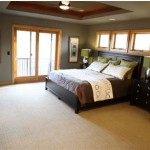Reptile Room Decor: Creating a Sanctuary for Your Scaly Friends
Reptiles are fascinating creatures that require specific environmental conditions to thrive. If you plan to welcome these exotic pets into your home, creating an aesthetically pleasing and functional reptile room is essential. Here's a comprehensive guide to reptile room decor, ensuring a comfortable and visually appealing space for your beloved reptiles.
1. Habitat Design
The most crucial aspect of reptile room decor is designing a suitable habitat. Start by selecting an enclosure that meets the size and species requirements of your reptile. Provide adequate space for movement, climbing, and hiding. Include a temperature gradient within the enclosure, with separate warm and cool zones. Humidity levels should also be closely controlled, using a humidifier or misting system as needed.
2. Substrate Choice
The substrate, or flooring material, plays a vital role in the reptile's health and well-being. Choose substrates that mimic the reptile's natural environment and are compatible with their specific needs. Cypress mulch, coconut fiber, or tile flooring are popular options that offer different levels of humidity retention and ease of cleaning.
3. Plants and Decor
Adding live or artificial plants to the reptile room can enhance the aesthetics and provide enrichment for the reptile. Choose plants that are non-toxic and appropriate for the species. Vines, succulents, and potted plants create a visually appealing backdrop and offer opportunities for climbing and hiding. Avoid overcrowding the habitat with excessive decor; aim for a balanced and natural look.
4. Lighting and Heating
Proper lighting and heating are essential for reptile well-being. Provide full-spectrum lighting that mimics natural sunlight, using bulbs or fluorescent fixtures. Heat sources should be strategically placed within the enclosure to maintain a temperature gradient. Under-tank heaters, ceramic heaters, or heat rocks can be used, depending on the reptile's species and habitat requirements.
5. Water Features
Many reptiles require access to water for drinking, bathing, and humidity regulation. Incorporating a water bowl or pond into the habitat is crucial. Choose a water container that is appropriate for the reptile's size and easily accessible. Ensure regular cleaning and water replacement to maintain water quality.
6. Hideouts and Shelters
Reptiles need secure hiding places to feel safe and reduce stress. Provide multiple hideouts of varying sizes and types, such as caves, burrows, or foliage. The hideouts should be placed in both warm and cool zones of the habitat, allowing the reptile to thermoregulate as needed. Artificial or natural shelters can be purchased or created using materials like hollow logs or cork bark.
7. Cleaning and Maintenance
Maintaining a clean and hygienic reptile room is paramount for the health of your pets. Establish a regular cleaning schedule, including spot cleaning daily or weekly. Thoroughly clean the enclosure, substrate, and all accessories regularly using appropriate cleaning agents. Proper waste disposal and disinfection practices are essential to prevent disease and odor.

Reptile Rack Animal Room Dream Rooms Fishing

Reptile Room In 2025 Animal House Rooms

Pin By S Kelly On House Ideas Animal Room Terrarium Reptile Habitat

Reptile Oasis Room Animal Rack

Pin On Reptile Room

What Do You Think Of My Reptile Room Reptiles Terrarium Animal

New Series What Goes On In My House Gecko Time

Pin By Sarah Jackson On Ideas For My Bedroom In 2025 Animal Room Reptile Dream House Decor

Exciting New Exotic Animal Displays In Our Reptile Room

Idea For Keeping Reptile Terrariums Room Terrarium Reptiles
Related Posts







